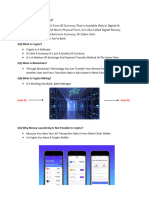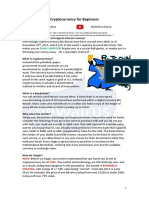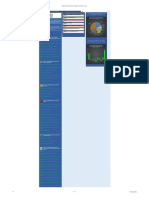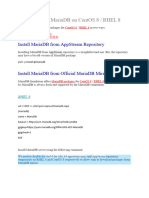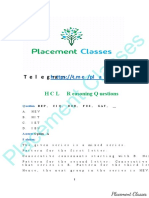Cryptocurrency Learning Path (Foundational to
Advanced)
1. Blockchain & Crypto Fundamentals: Start with trusted courses and books. For example, the
Wharton School’s free Coursera course “Cryptocurrency and Blockchain: An Introduction to Digital
Currencies” offers an accessible overview of Bitcoin, blockchain, crypto assets and market dynamics 1 .
UC Berkeley’s “Blockchain Fundamentals” (edX) program teaches Bitcoin/Ethereum basics, cryptography,
wallets and decentralized app concepts 2 . Core readings include The Basics of Bitcoins and
Blockchains by Antony Lewis (a clear beginner’s guide to Bitcoin, blockchain, wallets and exchanges 3
4 ) and Mastering Bitcoin by Andreas Antonopoulos (a deep technical exploration of Bitcoin’s
architecture and applications 5 6 ). For quick starts, Coinbase’s “Crypto Basics” section has concise
guides like “What is Bitcoin?”, “What is a blockchain?”, “How to keep your crypto secure?”, etc. 7 .
Resource Type Notes Cite
Cryptocurrency and Blockchain:
Online Bitcoin, crypto assets, market
Intro to Digital Currencies 1
Course structure; no prerequisites 1 .
(Wharton, Coursera)
Bitcoin/Ethereum basics: blockchain
Blockchain Fundamentals (UC Online
mechanics, wallets, smart contracts 2
Berkeley, edX) Course
2 .
Clear introduction to Bitcoin,
The Basics of Bitcoins and 3
Book Ethereum, blockchain tech, wallets,
Blockchains (Antony Lewis) 4
exchanges 3 4 .
Technical deep-dive on Bitcoin’s P2P
Mastering Bitcoin (Andreas 5
Book network, cryptography and scripting
Antonopoulos) 6
5 6 .
Beginner-friendly articles (“What is
Coinbase Crypto Basics (Coinbase
Website Bitcoin/Ethereum/blockchain”, myths, 7
Learn)
security, taxes) 7 .
• Cryptocurrency news & Q&A: Follow CoinDesk (a leading Bitcoin/digital currency news site) 8
and CoinTelegraph for market news, and use forums like BitcoinTalk.org or Reddit (r/
CryptoCurrency, r/Bitcoin) for community Q&A.
2. Buying, Storing & Using Crypto Securely: Learn safe practices. Use only reputable exchanges
(enable two-factor authentication, strong passwords, withdrawal whitelists) and move long-term
holdings into private wallets. A 2025 crypto security guide emphasizes: keep only actively-traded coins
on exchanges, secure accounts with 2FA, and “encrypt your wallet, back up your seed phrase, and
use a cold wallet if possible” 9 . Recommended hardware (cold) wallets include Ledger Nano
(supports 5,000+ assets, integrates with mobile apps and offers two-factor auth 10 ) and Trezor
(supports 9,000+ coins with high security, touch screen option 11 ). Software wallets include MetaMask
(leading Ethereum/ERC-20 wallet) and Electrum (Bitcoin-only) 12 . For example, Crypto.com’s Onchain
1
�DeFi Wallet (mobile/desktop) supports 1,000+ coins, DeFi staking/loans, and integrates with Ledger 13 .
Exodus (desktop/mobile) offers multi-asset support, Trezor integration and in-wallet trading 14 .
Wallet / Tool Type Use/Notes Cite
Cold storage for 5000+ coins, mobile app, 2FA
Ledger Nano X/S Hardware (cold) 10
support 10 .
Trezor Model Secure offline wallet for 9000+ coins, OLED/TFT
Hardware (cold) 11
One/T display, USB-only (no Bluetooth) 11 .
Crypto.com DeFi Mobile/Desktop Self-custody wallet (1000+ assets) with built-in
13
Wallet App DeFi lending/staking, Ledger integration 13 .
Software Multi-coin wallet with integrated exchange,
Exodus 14
(desktop/mobile) staking options, Trezor compatibility 14 .
Browser Popular Ethereum/ERC-20 wallet used for DeFi/
MetaMask 12
extension DApps 12 .
Bitcoin-only wallet favored by advanced users
Electrum Desktop wallet 12
12 .
3. Cryptocurrency Exchanges: To convert fiat to crypto, use top-rated exchanges. For example,
Investopedia (May 2025) recommends Coinbase (user-friendly for beginners), Kraken (very low fees),
Gemini (strong security for advanced users), Crypto.com (great mobile app, Bitcoin focus) and BitMart
(wide altcoin selection) 15 . Always enable 2FA, complete identity verification (KYC), and double-check
wallet addresses on withdrawals. Once acquired, transfer any long-term holdings to your own wallet
– as one guide advises, “Only keep crypto on an exchange if you’re trading it actively” 9 .
4. Analysis & Research Tools: Develop both fundamental and technical analysis skills. For
fundamentals, use sites like CoinGecko and CoinMarketCap to track prices, market cap, project metrics
and on-chain data (CoinGecko “tracks community growth, code development, major events and on-
chain metrics” 16 ). Professional platforms like Messari aggregate detailed project data, exchange
listings and funding rounds 17 . On-chain analytics (e.g. Glassnode for Bitcoin/Ethereum) uncover
network trends 18 . For technical analysis, learn chart patterns and indicators (RSI, MACD, moving
averages) via tutorials or courses. Tools like TradingView provide advanced charting and indicators.
Educational sites like Investopedia and BabyPips (for general TA concepts) or YouTube channels
(DataDash, TheChartGuys) can teach pattern recognition and trading strategies. Combining both
analyses – e.g. comparing token valuations against fundamentals and market trends – is key.
5. Decentralized Finance (DeFi): Once comfortable, study DeFi – lending, DEXes, stablecoins, etc. A top
resource is Coursera’s “DeFi and the Future of Finance” (Duke Univ.) specialization, a 4-course series
covering DeFi history, building blocks, major protocols (MakerDAO, Compound, Aave, Uniswap, dYdX)
and risk management 19 . You’ll learn how smart contracts enable decentralized lending/borrowing and
trading without banks. Other resources include DeFi Pulse (on-chain DeFi TVL analytics) and the
Crypto.com DeFi wallet 13 . YouTube (e.g. Finematics) offers visual explainers of how these protocols
work. Practice on testnets or by small trades: try depositing into a lending pool or swapping tokens on
a DEX to see mechanics firsthand.
6. NFTs (Non-Fungible Tokens): Learn what NFTs are and how to trade/create them. NFT basics are well
explained by Coinbase: “NFTs are unique cryptoassets… used to authenticate ownership of digital items
like art or virtual goods” 20 . Minting (creating) an NFT means writing the item to a blockchain,
2
�establishing an immutable ownership record 21 . Practical guides (e.g. OpenSea’s “How to Mint NFTs”)
walk you through using wallets like MetaMask to mint and list NFTs. To gain proficiency, study platforms
like OpenSea and Rarible, experiment with minting dummy NFTs on testnets, and follow NFT artists or
communities on Twitter/Discord for trends and tips. (Courses like “Certified NFT Expert” by Blockchain
Council may also be of interest, but always check quality and reviews.)
7. Crypto Taxation & Regulation: Understand tax and legal rules in your jurisdiction. In the US, for
example, crypto is taxed as property: selling or trading crypto triggers capital gains/losses 22 . Mining
or receiving crypto as payment is taxable income (reported at fair market value) 23 . New IRS rules
(effective 2025–26) require brokers to issue Form 1099-DA reporting gross proceeds (and later cost
basis) of crypto sales 24 . Tools like Koinly or CoinTracker can automate gains/losses calculation.
Globally, regulations vary. The EU’s Markets in Crypto-Assets (MiCA) regime (mid-2024) imposes
licensing and AML requirements on crypto firms 25 . However, worldwide crypto regulation is “still
being researched, developed, and implemented” – consumers should stay updated 26 .
8. Advanced Trading Strategies: After mastering basics, learn advanced tactics. These include
leverage and derivatives (margin trading, futures, perpetuals on platforms like Binance or dYdX),
algorithmic trading bots, arbitrage (exploiting price differences between exchanges), and hedging
techniques. Explore concepts like market-making or statistical arbitrage, but practice with care in
demo/small accounts first. Yield farming (in DeFi) – moving assets between protocols for rewards – is
another advanced topic (courses and DeFi blogs often cover strategies and risks). Key is rigorous risk
management: set stop-losses, diversify positions, and keep up with fast-moving news.
9. Portfolio Management: Finally, structure a well-diversified crypto portfolio. Apply modern portfolio
theory: measure risk (e.g. Bitcoin’s beta vs your overall portfolio) and use metrics like the Sharpe ratio
for performance 27 . The Wharton crypto course covers how to compute Beta/Alpha of Bitcoin to gauge
systematic risk 27 . Tools like CoinTracker or Delta help track all holdings in one place and automate
rebalancing alerts. Aim to spread investments (e.g. between Bitcoin, Ethereum, a few altcoins,
stablecoins, possibly DeFi tokens) and rebalance periodically to maintain your desired allocation. Always
invest only what you can afford to lose, given crypto’s volatility.
Additional Resources & Communities: Learn continuously from experts and peers. YouTube channels
like Andreas M. Antonopoulos (technical talks), Coin Bureau (coin/project overviews), DataDash (market
analysis), and Finematics (DeFi explainer videos) are highly rated educational channels. Forums and
social media: Reddit’s r/CryptoCurrency and Twitter/X (many crypto influencers) are active discussion
hubs. Analytical tools: Use TradingView (advanced charting), Etherscan/Polygonscan (blockchain
explorers), and APIs (CoinGecko, Messari 17 ) for research. Always check multiple sources before acting.
Summary: A structured learning path is key: start with fundamentals (courses/books), then secure
practices and basic investing, and progressively move into analysis techniques, DeFi, NFTs, and
advanced trading. Each topic has reputable resources (courses, websites, communities) updated for
2024–25 as cited above. By following this sequence—from understanding blockchain to mastering
portfolio management—one can build strong skills in using and investing in cryptocurrency.
Sources: Authoritative educational platforms (Coursera, edX), financial publications (Investopedia,
NerdWallet), crypto industry blogs, and official guides (Coinbase Learn, OpenSea Learn, course
descriptions) have been cited throughout 1 2 3 10 15 9 16 17 19 20 24 22 . Each resource
was chosen for credibility, recency (2024–2025), and educational value.
3
� 1 27 Free Course: Cryptocurrency and Blockchain: An Introduction to Digital Currencies from
University of Pennsylvania | Class Central
https://www.classcentral.com/course/wharton-cryptocurrency-blockchain-introd-13733
2 Online Course: Blockchain Fundamentals from University of California, Berkeley | Class Central
https://www.classcentral.com/course/uc-berkeleyx-blockchain-fundamentals-18439
3 4 Amazon.com: The Basics of Bitcoins and Blockchains: An Introduction to Cryptocurrencies and
the Technology that Powers Them (Cryptography, Derivatives Investments, Futures Trading, Digital
Assets, NFT): 9781633538009: Lewis, Antony: Books
https://www.amazon.com/Basics-Bitcoins-Blockchains-Introduction-Cryptocurrencies/dp/1633538001
5 Mastering Bitcoin: Unlocking Digital Cryptocurrencies: Antonopoulos, Andreas M.:
6
0783324910469: Amazon.com: Books
https://www.amazon.com/Mastering-Bitcoin-Unlocking-Digital-Cryptocurrencies/dp/1449374042
7 Crypto basics
https://www.coinbase.com/en-it/learn/crypto-basics
8 CoinDesk - Wikipedia
https://en.wikipedia.org/wiki/CoinDesk
9 2025 Guide: What You Need to Know to Invest in Crypto Safely | Security.org
https://www.security.org/digital-security/crypto/
10 11 12 13 14 9 Best Crypto Wallets for 2025 - NerdWallet
https://www.nerdwallet.com/p/best/investing/crypto-bitcoin-wallets
15 Best Crypto Exchanges and Apps for May 2025
https://www.investopedia.com/best-crypto-exchanges-5071855
16 Crypto Market Cap Charts | CoinGecko
https://www.coingecko.com/en/global-charts
17 About Messari
https://docs.messari.io/docs/about-messari
18 Glassnode - On-chain market intelligence
https://glassnode.com/
19 Decentralized Finance (DeFi): The Future of Finance | Coursera
https://www.coursera.org/specializations/decentralized-finance-duke
20 What is a non-fungible token (NFT)? | Coinbase
https://www.coinbase.com/learn/crypto-basics/what-are-nfts
21 How to Mint NFTs: Step-by-Step Creation Guide for Beginners
https://opensea.io/learn/nft/what-is-minting-nft
22 23 Do I Have to Report Crypto on Taxes? Your Crypto Tax Guide - TurboTax Tax Tips & Videos
https://turbotax.intuit.com/tax-tips/investments-and-taxes/your-cryptocurrency-tax-guide/L4k3xiFjB
24 A Beginner’s Guide to New U.S. Crypto Tax Rules | Coinbase
https://www.coinbase.com/learn/crypto-taxes/whats-new-crypto-tax-regulation
25 26 Cryptocurrency Regulations Around the World
https://www.investopedia.com/cryptocurrency-regulations-around-the-world-5202122




































